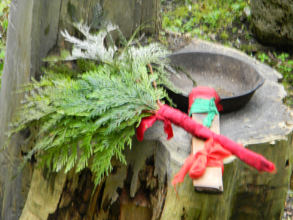Holistic Balance
p>The health of First Nations, Inuit, and Metis peoples has become a critical issue for most Canadian health regions, including British Columbia. It has become common knowledge that mainstream health initiatives do not work well with First Nations people, and they often suffer from the effort. Before colonization, First Nations people had a sophisticated system of healing and living that made them the hardiest people on the planet. This knowledge still exists and deserves a rightful place in the Canadian health care system. First Nations knowledge has a place in health care and society at large. It is important that Canadians develop understanding of First Nations explanatory models about health, healing, life and spirituality.

First Nations knowledge is strongly linked to the natural world: First Nations languages, cultural practices, and oral traditions are all intimately connected to the Earth. First Nations people see their relationship with each other and with the Earth as an interconnected web of life, which manifests as a complex ecosystem of relationships. Balance and holistic harmony are essential tenets of this knowledge and subsequent cultural practices. Embedded too is a keen belief in both adaptability and change, but change that further promotes balance and harmony, not change that creates distress, death, and the depletion of the Earth’s populations and resources. Careful observation of the seasons and the cycles of life foster an appreciation for the impermanence of things, including humans, as well as the interdependence of all life forms with each other.
Contrary to popular belief, the First Nations way is not one of living in the past, but continually adapting to the now, and considering the impact of all actions on the seven generations to come. Thus, western thinking could be enriched if some of the processes naturally used in First Nations cultural thought were heeded. Rather than leading First Nations people to think in a ‘modern’ way, non-Aboriginal people could adopt a more balanced, holistic, ecologically responsible mindset that could enhance the health and well-being of all – First Nations, non-First Nations, human, animals, plants, as well as the Earth herself.
The critical importance of holistic balance of body-mind-heart-spirit is central to individual, family, and community health for all First Nations peoples. This balance is essential for well-being and all four aspects of the individual ideally work together in harmony in each moment to promote adaptation to life’s situations and activities.
Indigenous knowledge tells us that individual balance is intricately bound to interconnection with one’s immediate family, extended family, one’s community and one’s relationship with the world at large, both natural and spiritual.
Many First Nations, Inuit, and Metis organizations and communities are working to holistically address the residual effects of colonialism, including the effects of the Indian Act, and the reservation and residential school systems. Individual balance as well as harmony with others and the world around us is a key to both vibrant health and healing from the past. First Nations knowledge also reinforces that healing is like embarking on a journey, it requires daily activity and movement, and engagement with balancing practices that fortify all aspects of the self, physical, mental, emotional, and spiritual.
In the context of First Nations healing, the healing must occur at a community level, it goes beyond any one individual. If families and communities are on a strong path of healing, this is going to influence each individual person within the community, from newborns to Elders. Since the healing of First Nations people must go beyond the common stresses and issues of contemporary life due to colonialism, intensive practices of spiritually-based, holistic and transforming healing modalities are necessary, preferably, at a community level. Healing within the individual, the family, and the community is best embraced as a dynamic and integrative process.
Process
Personal development is one of the best ways to protect health and promote well-being. It is also one of the essential ingredients for developing the ability to cultivate deep relational engagement with other people. Holistic personal development refers to optimal, integrated development of one’s body, mind, heart or emotions, and spirit.
Although in essence, we are whole beings, it is useful to describe holistic personal development by categorizing the different aspects of ourselves into physical, mental, emotional, spiritual, and professional dimensions. Each aspects relates to important needs or states that we must achieve to be holistically developed and well. Each aspect also serves to equip you to develop relational engagement with your families, your peers and community, and so on, within your education and future career. The integration of all aspects form a cohesive whole that serves you well in sustaining a healthy and happy life.
Physical Development
Fitness, nutrition, communion with the natural world, relaxation, sensory, tactile, and haptic stimulation
Mental Development
Intellectual stimulation, critical awareness, reflection, intuition, inquiry, visualization, pattern recognition, decision-making, problem-solving, analysis, synthesis, evaluation
Emotional Development
Healthy relationships, balanced emotions, caring capacity, empathy, interconnectedness, compassion, self-expression, empowerment
Spiritual Development
Inner guidance, higher purpose, calling to serve, deep inspiration, soul evolution
Professional Development
Life Path, career goals, life-long learning, Portfolios, Mentors, networking
Preparation
READ: First Nations Health Council. (2010). The BC First Nations ActNow Toolkit. West Vancouver: FNHC. http://www.fnhc.ca/pdf/60322_FNHC_ActNow_Toolkit.pdf
Personal Development Plan Worksheet
Download and complete the worksheet by including at least one goal with targets and strategies for each dimension – Physical, Mental, Emotional, Spiritual, and Professional. Save and store your sheet for future reference. Continue to track and refine your goals over time. Make sure these are goals you actually do want to work toward, then start to work towards them in your life!
Developed by June Kaminski, 2013
|